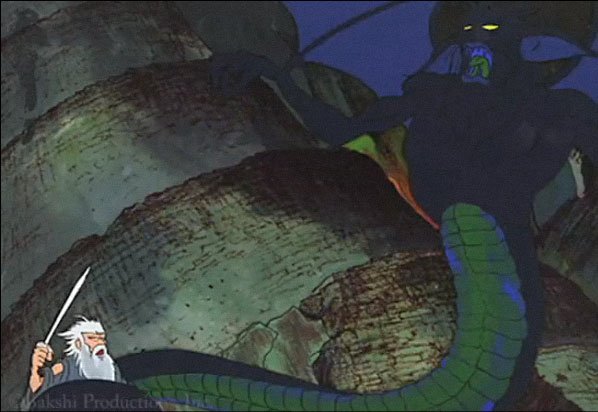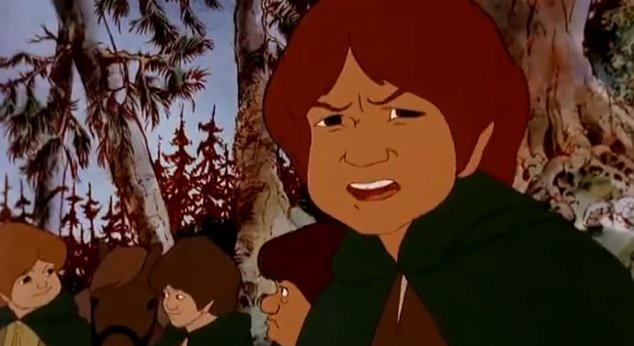Lost Bakshi Lord of the Rings footage found

Over at BoingBoing, I posted a short piece about new, previously unseen footage from the love-it-or-hate-it 1978 Ralph Bakshi Lord of the Rings adaptation. Turns out, Bakshi (actually, his son Eddie) has unearthed some unfilmed cel animation art that was never previosuly used. Those drawings have recently been filmed...

Over at BoingBoing, I posted a short piece about new, previously unseen footage from the love-it-or-hate-it 1978 Ralph Bakshi Lord of the Rings adapatation. Turns out, Bakshi (actually, his son Eddie) has unearthed some unfilmed cel animation art that was never previosuly used. Those drawings have recently been filmed, and posted on Bakshi's Facebook page. The two "new" scenes --- which feature the Gandalf and Balrog fight, as recalled by Gandalf later after he's come back from the dead --- are brief. But they are worth looking at, if for no other reason than to revisit Bakshi's visually memorable but flawed movie.
I was lucky to have interviewed Bakshi back in 2006, as well as last week for this post. Bakshi is one of my childhood heroes (along with filmmakers Disney, Lucas and Spielberg), and his Rings was my first ever introduction to Toklien --- and I suppose my gateway drug to D&D.
 If you recall, Baskhi's film left viewers high and dry about 2/3 of the way through the Tolkien epic. The director never got to make a "part II" to the film, despite the Bakshi version of Rings making money --- $30 million on a $4 million budget, according to Box Office Mojo (though when I interviewed Bakshi in 2006, he told me it cleared $90 million on a $8 million budget).
If you recall, Baskhi's film left viewers high and dry about 2/3 of the way through the Tolkien epic. The director never got to make a "part II" to the film, despite the Bakshi version of Rings making money --- $30 million on a $4 million budget, according to Box Office Mojo (though when I interviewed Bakshi in 2006, he told me it cleared $90 million on a $8 million budget).
When you see the footage, you'll be reminded of some of the troubling differences between the way characters were animated --- sometimes traditionally-animated, sometimes using rotscoping (or tracing live footage for animators to use as a guideline).
I asked Bakshi about this, why specifically in the new footage do Gandalf and the Balrog appear differently, almost cartoonish, compared to the rotoscoped Gandalf and Balrog seen on The Bridge of Khazad-dûm. “Well, it’s hazy," Bakshi, now 75, said, "but I was trying to make memories different than the real time story. I was wrestling with trying to separate the styles.”
Indeed, those days are hazy. But a fun trip to revisit them. Enjoy.
Why Ray Harryhausen's stop-motion effects were more real than CGI
 The death of stop-motion animation pioneer Ray Harryhausen raises questions about the future of special effects, writes Ethan Gilsdorf. In the good old days, it did not take so much to trick the eye.
The death of stop-motion animation pioneer Ray Harryhausen raises questions about the future of special effects, writes Ethan Gilsdorf. In the good old days, it did not take so much to trick the eye.
"There comes a point where people will reject digital effects and want movies where we actually did something in real space, and real time.”
That's a quote from a film director perhaps the least likely to decry computer-generated special effects: Peter Jackson. Interviewed for the 2011 documentary Ray Harryhausen: Special Effects Titan, Jackson said, essentially, that as digital special effects in movies become increasingly advanced, we'll crave the real even more. Real, as in "real" fake -- physical puppets of gorillas and T-Rexes, Medusas and animated statues, not ones made from pixels. Real, as in physical models manipulated by hand and filmed one frame at a time, not rendered in some fancy computer program.
But Jackson's comment about a movie being something that happens "in real space, and real time" feels surprising, if not ironic. The director most known for creating miniature models and sets (and so-called giant miniatures, or "bigatures") for The Lord of the Rings, and seamlessly mixing them with digital trolls and elves, later turned away from the "real" miniatures he used in that trilogy. In his last film,The Hobbit: An Unexpected Journey, Jackson finally and fully embraced digital effects. It's a film in which nary a miniature or puppet exists.
Now, the death on May 7 of stop-motion animation pioneer Ray Harryhausen poignantly brings these issues of real and fake, analog and digital, info focus. Harryhausen's passing represents the end of an era. It closes a crucial chapter in special effects history. It's also a kind of turning point in film technology. From here on out, it's too late to return to the analog.
If you don't know who Harryhausen was, you've probably seen his work. The master animator is best known for breathing life into giant, writhing serpents, sword-wielding skeletons, and marauding dinosaurs in such fantasy adventure and monster movies as The 7th Voyage of Sinbad(1958), Mysterious Island (1961), Jason and the Argonauts (1963), and Clash of the Titans (1981). Harryhausen was an innovator, and in many ways the father of the modern special effects craft and industry.
Harryhausen's trademark action sequences featuring animated model figurines -- always pictured interacting with, or more often, fighting with human foes, or crushing them, or biting them in half or flying away with them -- might seem clunky and old-fashioned when measured by today's standards. But in their day, the effects Harryhausen pioneered were cutting-edge. He painstakingly filmed his "creatures" frame by frame. The process was exhausting: The 4 minute, 37-second skeleton and human fight sequence from Jason and the Argonauts reportedly took four and a half months to photograph and Harryhausen had to readjust and film around 184,800 movements of the puppets.
Then, using his patented "Dynamation" technique, those skeletons and serpents could interact on screen with actors in a remarkable realistic way. The Dynamation process combined foreground and background footage by photographing miniatures in front of a rear-projection screen. Sometimes, he shot sequences through a partially-masked glass pane. Live footage would later be superimposed on the masked portion of the frame, and voila, the creature or creatures seemed to exist in the midst of "real" human-scaled action, or even appear to move in front of and behind "live" elements. Harryausen also carefully controlled lighting and color balance to make sure the image quality of his animated sequences matched the quality of the live action. His effects were more convincing than the standard use of optical printing and mattes. This was before green screen, folks.
New Pixar Movies Announced
[this post originally appeared on wired.com's Geek Dad]
 Retro video game fever: A still from "Wreck-It-Ralph"It’s the 25th anniversary of Pixar Animation Studios, the obscenely-successful cartoon company that has pretty much revolutionized the animation business. The company began in 1979 as the humble Graphics Group, once part of Lucasfilm; then it was snagged by Steve Jobs over at Apple in 1986, before finally being bought by The Walt Disney Company in 2006. Value at time of sale? $7.4 billion. According to Business Week, the transaction made Jobs the largest shareholder in the Disney empire.
Retro video game fever: A still from "Wreck-It-Ralph"It’s the 25th anniversary of Pixar Animation Studios, the obscenely-successful cartoon company that has pretty much revolutionized the animation business. The company began in 1979 as the humble Graphics Group, once part of Lucasfilm; then it was snagged by Steve Jobs over at Apple in 1986, before finally being bought by The Walt Disney Company in 2006. Value at time of sale? $7.4 billion. According to Business Week, the transaction made Jobs the largest shareholder in the Disney empire.
Anywho, Pixar has continued its forward march into blockbuster heaven with this summer’s Cars 2, which despite mixed reviews has already reached the $500,000 worldwide gross mark. Yee haw.
At D23 expo, Disney’s own Comic-Con-like, fanboy/girl event that wrapped up Sunday in Anaheim, California, production company big-wigs announced the line-up of animated Disney films for the next two years, 2012-2014.
As reported on BuzzSugar, Pixar projects in the pipeline include:
The Untitled Pixar Movie About Dinosaurs: “What the world might have been like if dinosaurs were never wiped out by a giant asteroid, but continued to exist on Earth.” Holiday 2013 release.
The Untitled Pixar Movie That Takes You Inside the Human Mind: “explor[ing] the reasons why we get songs stuck in our head, why we dream, and even why we remember.” Spring 2014 release.
 Scottish heroes: A still from the Pixar movie "Brave"Brave: ”Pixar’s first female-driven film stars Boardwalk Empire’s Kelly MacDonald as Merida, a princess set on escaping her fate of an arranged marriage to one of three idiot clan leaders.” With Billy Connolly and Craig Ferguson. June 22, 2012 release.
Scottish heroes: A still from the Pixar movie "Brave"Brave: ”Pixar’s first female-driven film stars Boardwalk Empire’s Kelly MacDonald as Merida, a princess set on escaping her fate of an arranged marriage to one of three idiot clan leaders.” With Billy Connolly and Craig Ferguson. June 22, 2012 release.
Monsters University: A prequel to Monsters Incorporated “that will take us back in time to show how Mike and Sully became buddies.” Billy Crystal and John Goodman return. 2013 release.
And here are two releases not technically from Pixar, but from DisneyToon Studios and Walt Disney Animation Studios, which like Pixar are overseen by cartoon god John Lasseter, but are separate and independent studios within the Disney animation empire:
Wreck-It Ralph: “Inside the world of retro, 8-bit video games” with a look that apparently “stay[s] true to the look of classic video games.” With the voice talents of John C. Reilly and Sarah Silverman. 2012 release, from Walt Disney Animation Studios.
Planes: Cars but with airplanes. “The only non-Pixar animated project debuted at D23, Planes stars John Cryer as Dusty, a cropduster who decides to take off an adventure around the globe.” Spring 2013 release, from DisneyToon Studios.
Clearly, even at the ripe old age of 25, Pixar shows no signs of stopping.